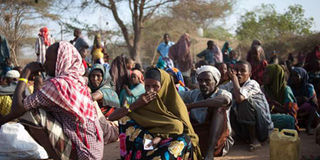Refugees: World won’t listen to Kenya

Somali refugees at the Dagahaley Refugee Camp in Kenya. The government has closed down the Dadaab and Kakuma refugee camps, which are home to some 600,000 refugees, mostly from Somalia, South Sudan. PHOTO | AFP
What you need to know:
- The country hosts some 600,000 asylum seekers, most of them in Kakuma and Dadaab camps.
- Although an elected government is now in place, Somalia remains unstable, with warlords controlling various pockets of the country.
- Kenya says the Somalia-based terrorist network is using the refugee camp to launch attacks.
- The international community has done little to support it, leaving it to bear the cost of hosting the refugees.
The announcement that the government planned to shut down the Dadaab refugee camp did not come as a surprise to many foreign policy observers.
For almost a quarter of a century, Kenya has played host to hundreds of thousands of refugees fleeing violent conflict, political repression, or famine. Kenya hosts some 600,000 refugees, most of them in Kakuma and Dadaab camps.
The Kakuma refugee camp was set up in 1992 in the present day Turkana County to accommodate the so called “Lost Boys” fleeing the civil war in the southern part of the then Sudan.
With the 2005 peace deal leading to South Sudan’s independence in 2011, it was hoped that Kakuma camp would close and the refugees return home voluntarily. However, due to the latest conflict pitting President Salva Kiir against Vice -President Riek Machar, it received 80,000 more refugees. There is hope that with the latest peace deal between the two, the refugees will soon be able to return home.
The outlook is quite different for Dadaab camp. Although an elected government is now in place, Somalia remains unstable, with warlords controlling various pockets of the country. Without the support of the international community, there would be no government to talk about.
The refugee camps have cost Kenya dearly, with frequent terrorist attacks over the past decade-and-a-half being linked to Al-Shabaab cells in the Dadaab camp. Kenya says the Somalia-based terrorist network is using the refugee camp to launch attacks.
The local environment has also borne the brunt of the high population in the sprawling camps while tension between the refugees and local people has been palpable. Located in the semi-arid north, the camp’s environmental cost is yet to be fully accounted for.
Despite Kenya’s generosity, the international community has done little to support it, leaving it to bear the cost of hosting the refugees.
Interestingly, Turkey, which has taken in three million refugees, mainly from Syria, will reportedly receive billions of dollars from the European Union.
Previous attempts to close the camps in Kenya have been postponed or met with resistance, with the UNHCR citing the UN Refugee Convention, which Kenya has both signed and ratified. Parties to the convention cannot forcibly repatriate refugees. In fact, refugees are expected to enjoy all the universal rights that citizens are entitled to.
NEED FOR SUPPORT
Legally therefore, Kenya cannot just wake up and shut down the two camps. As a responsible member of the international community, violating international law would send the wrong signals to its development partners and cannot be without consequence.
The Interior Ministry’s announcement was likely designed to draw the attention of the international community to Kenya’s need for support.
That support would be necessary to help it police its porous borders, which has made that part of the country a playground for Al-Shabaab and its sympathisers. It could also be used to restore the environmental integrity in and around the refugee camps and provide support to the local communities, many of whom live in abject poverty.
The trouble with Kenya’s expectation of support is that the refugee crisis is growing worldwide, with the European Union itself working overtime to deflect Syrian refugees from entering its territory. The international community is unlikely to consider Kenya’s case as particularly urgent or worthy of attention.
Under the UN convention, Kenya has the option of encouraging the refugees to voluntarily return to their countries of origin in a usually delicate arrangement coordinated by the UNHCR.
With relative stability in South Sudan and parts of Somalia, this option is viable but costly. The refugees do not only have to be helped to return (if they wish to), they have to be helped to settle in their new homes in the best way possible.
Alternatively, Kenya can seek the help of a third country to take in some of the refugees. The final option is to integrate some of the refugees locally so that there is no need for them to return to an uncertain life.
It is notable that a significant percentage of the refugee population was born and raised in Kenya. These children went to school here, married and developed careers or enterprise. They simply know no other life.
Ms Muriithi is chief communications adviser at the Africa Centre for Strategic Futures, Kenya Project. [email protected]




